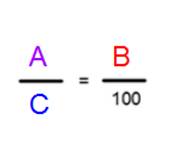Percentage problems such as “8 is what percent of 40?” will be a snap for you if you remember this simple procedure. The trick is to set the problem up as a simple proportion—in other words, you make two fractions equal to each other. Then all you have to do is place all the numbers in the correct positions by following the rules below. Let’s see how to solve the problem above.
- First, write two fractions, but put only the 100 on the bottom of the right fraction:
- Now, look at the problem and find the number right after the word “of”. In this case, it’s 40. Place that number on the bottom of the left fraction:
- Next, find the number right before the word “percent”. This number goes over the 100. In this problem, there is no number before “percent”; it’s the word ‘what’. When you see ‘what’, that’s your variable! Place an x over the 100.
- The last number goes on the top of the left fraction. In this problem, that’s 8.
- Once you’ve filled in all the spaces, you solve the usual way, by cross-multiplying:
40x = 800
x = 20. So 8 is 20% of 40.
We can summarize by describing a general percentage problem: A is B percent of C?
Here, A, B and C represent numbers or the word ‘what’ (in which case it is the variable). C (the number following ‘of’) goes on the bottom next to the 100. B (the number before ‘percent’) goes above the 100, and A (the remaining number) goes in the last space. Then cross multiply and solve.





